WIRE INTRODUCTION

The above picture is commonly used, and it is also several kinds of hook-and-loop lines that are relatively easy to buy on the market. It's hard to say which line is particularly good, or particularly bad. Fishing friends should choose the appropriate hook line from the three perspectives of fishing method, tying method and personal experience. Of course, strength and wear resistance are our primary considerations. Because the hook line is likely to directly touch the mouth of the fish, especially those fish with sharp teeth and sharp teeth, in this link, try to ensure as much safety as possible. Don't regret running the fish because of the problem of the line and the binding method.
1) YGK Zylon thread, a high-strength and high-elasticity fiber developed by Japan Toyobo, brown, up to No. 100, relatively thick.
2) YGK GALIS SEA HUNTER dark red, the thread feels very hard and has good wear resistance.
3) VARIVAS SS ASSISTLINE, dark red, relatively soft, fades after water.
4) YGK GALIS ISO HUNTER, white, soft to the touch.
5) YGK GALIS ULTRA orange, double-layer fiber structure, the outer layer is smooth and wear-resistant.
6) AMIKA gold thread, khaki, single-layer braided structure.
7) Other bulk braided wires.
Basically, the material of the hook thread is developed in Japan, and even if it is woven and repackaged in China, its original fiber is also produced in Japan. If it is not made of specific fibers, it is difficult to meet the requirements of high strength and high wear resistance.
PREPARE THE NECESSARY TOOLS

Tie method 1: single-strand double-hook
This tying method is very popular all over the world, it is easy to learn, and it is also a very economical tying method. Another advantage of this tying method is that the upper and lower hooks are staggered in length. During the fall of the iron plate, the two hooks are scattered in different areas around the iron plate, which is helpful to improve the hook rate. But please don't try it with too soft wire, because the two hooks are on the side of the iron plate. A thread that is too soft will cause the two hooks to become entangled.
Step 1: Wrap 2-3 circles around your thumb or index finger

Step 2: Pass the thread through the middle

Step 3: Look at the knot from the side, and then pass the hook through the hole
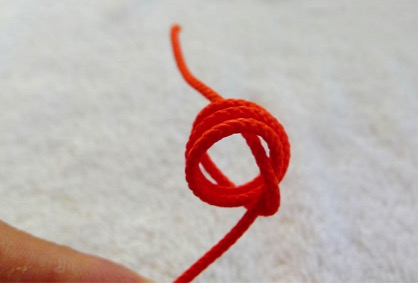
Step 4: Thread the hook into the middle

Step 5: Tighten the thread, as tight as possible

After throwing out the line, lightly touch the fishing line that slips out of the reel with your left hand to avoid the line going out too fast and the bus line falling.
Step 6: It is very important that the thread ends pass through the hook handle from the hook door.

Step 7: Look at the knot from another angle

Step 8: Hook the other end of the thread in the same way

Step 9: After putting on the heat shrinkable tube, heat it up

Step 10: it's done

Step 11: Tie it to the iron plate. The best condition is that the two hooks are scattered, and they are in one-third of the iron plate.

Tie method 2: double-strand single hook I

Although this double-line and single-hook binding method is not unique to Taiwan JIGMASTER, because Taiwan JIGMASTER entered the mainland relatively early, its understanding of iron plate fishing and commonly used techniques have a deep impact on mainland fishermen. In particular, this binding method seems to be the only choice for mainland fishermen to a certain extent.
Any binding method has its advantages and disadvantages, and this double-line single-hook binding method does have its own uniqueness. When the hook-binding line has a certain hardness and is relatively short, the iron hook is very warped, so as to reduce the iron hook hanging on the iron plate during the baiting process, resulting in missed hooks. An added bonus is that even if one thread is cut, the other thread can still work when it comes to sharp-toothed fish. Obviously, if you use this method to tie a long wire, it will weaken its advantages. Therefore, this double-line binding method is not suitable for those fishermen who are used to long lines.
Step 1: Fold the hook line in half

Step 2: Wrap 1-2 circles around the thumb or index finger

Step 3: Pass the thread through the middle

Step 4: Thread the hook into the middle

Step 5: Tighten the thread, as tight as possible

Step 6: It is very important that the thread ends pass through the hook handle from the hook door.

Step 7: After putting on the heat shrinkable tube, heat it up
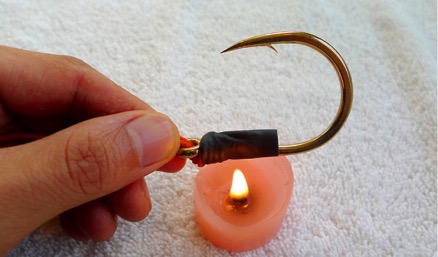
Step 8: Success

Step 9: Tie on the iron plate.

Tie method 3: double-strand single hook II

The essence of this binding method is the same as that of the previous binding method. It can be tied with different lengths according to the fishing habits. But this tying method also has a premise, to use a hollow hook thread so that the thread can pass through the middle.
Step 1: Fold the hollow hook line in half

Step 2: Fold the steel wire in half, thread it from the middle of the hook thread, and thread it to about half the distance

Step 3: Pass the other end of the hook wire through the wire, then pull the wire inward, and drive the other end of the wire to pass through the middle of the hook wire.

Step 4: Pull out the thread

Step 5: At this point, the two shares at the other end merged into one

Step 6: Wrap 1-2 circles around the thumb or index finger

Step 7: Pass the thread through the middle

Step 8: Thread the hook into the middle

Step 9: Pass the thread from the hook door outwards through the hook handle
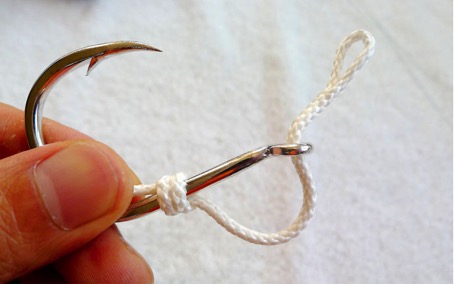
Step 10: Tighten the thread, as tight as possible

Step 11: After putting on the heat shrinkable tube, heat it up

Step 12: Success

Step 13: Tie on the iron plate.

Tie method 4: four-strand single hook

If you pursue ultimate strength, bite resistance, and DIY aesthetics. Then this kind of complicated hooking method will definitely satisfy you. It is hand-woven into one strand from four hollow hook-binding threads, and the actual strength is much greater than that of four single strands. It is very line-consuming and time-consuming, which is also the reason why this binding method cannot be widely promoted. But from the perspective of exploring, trying, and pursuing the ultimate, there are reasons for its existence.
Step 1: Fold the two hollow hook-binding lines in half. For clarity, one is line A and the other is line B.

Step 2: The steel wire is threaded into the interior from the middle part of the hollow hook line A, and then threaded out from the front. The distance is about 3-4 cm.
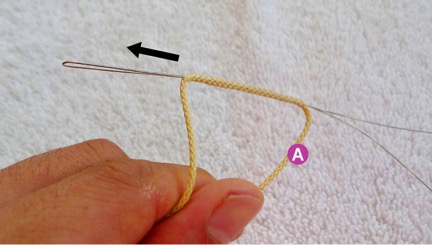
Step 3: Thread another hook thread B thread into the steel wire, then pull inward

Step 4: That is to say, this hook-binding line B is passed through the hollow interior of the other hook-binding line A.
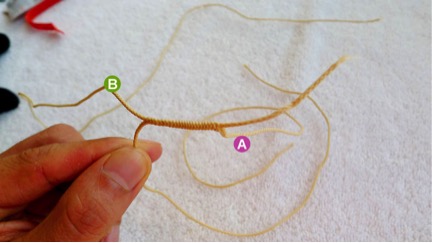
Step 5: Line A and Line B are in the middle part and overlapped together
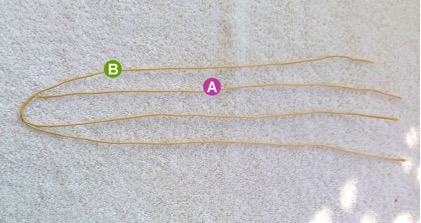
Step 6: Details Display

Step 7: Begin to braid, cross the four strands to each other and weave tightly together

Step 8: Fixing in one position will help you to make the thread more compact

Step 9: Braided Lines

Step 10: Tie the hook and put the finished product on the heat shrinkable tube. The process of tying the hook will not be introduced here, it is the same as the previous ones.

Step 11: Exquisite and powerful invincible iron hook binding method


